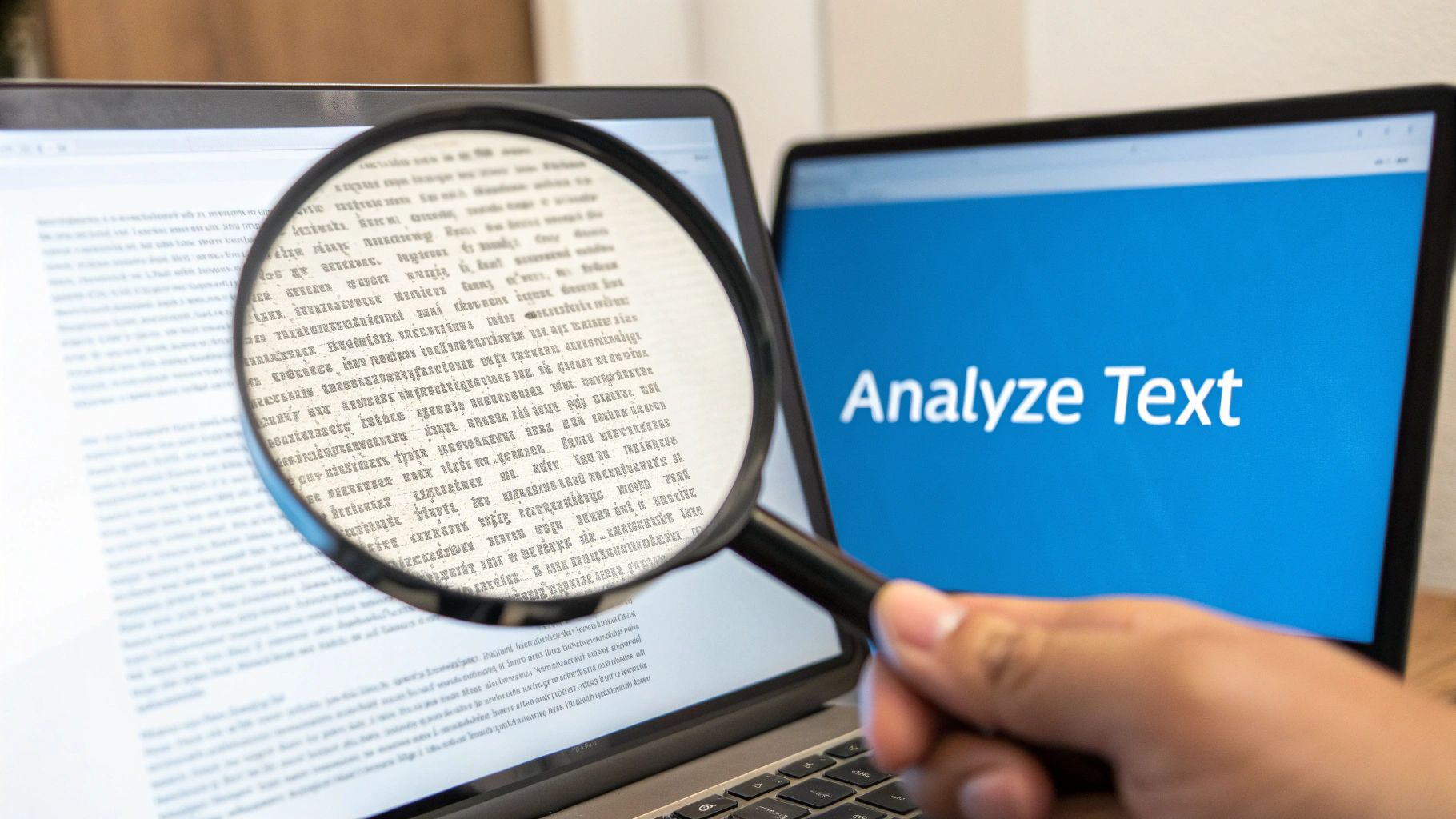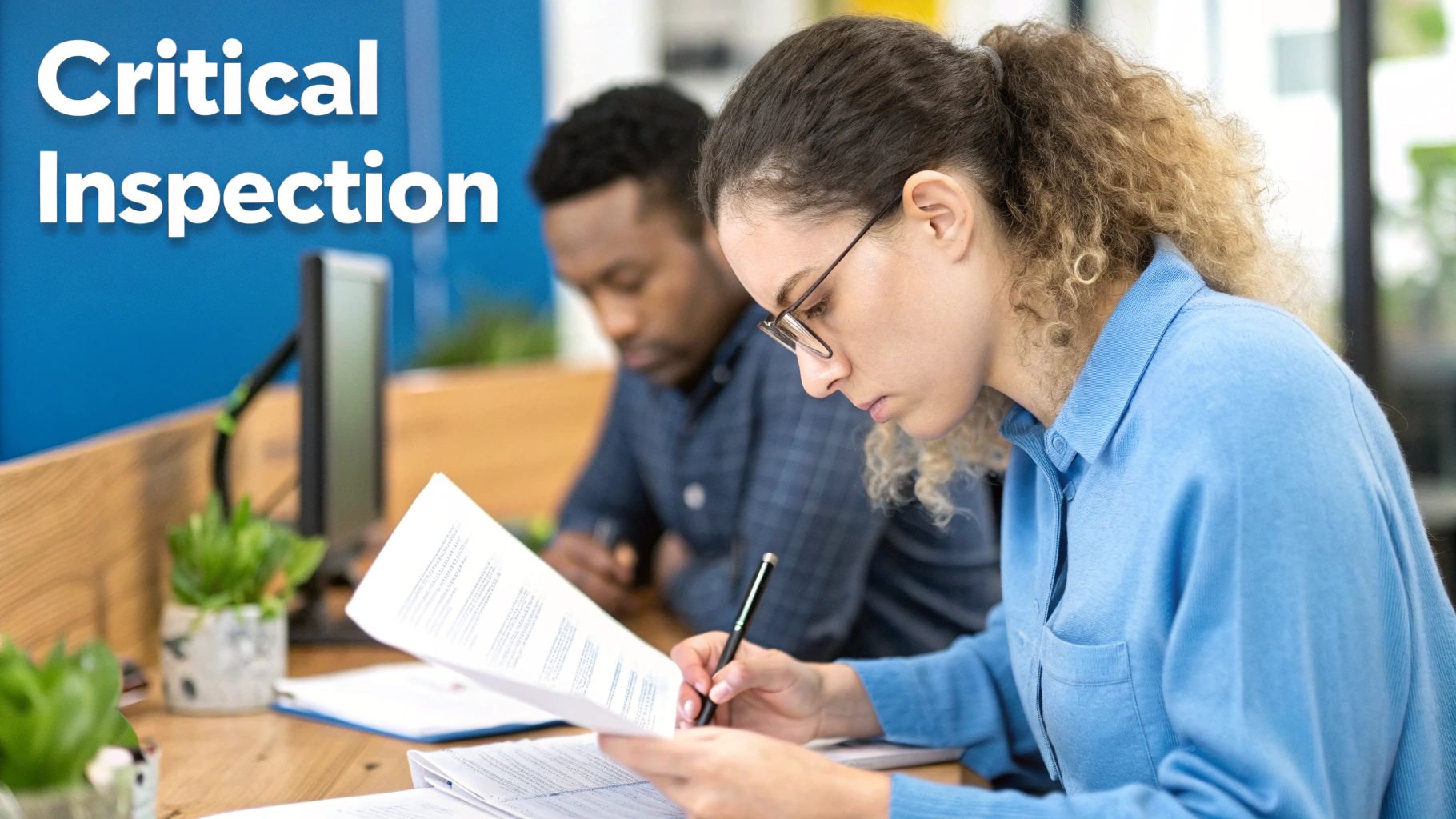Understanding Today's AI Content Detection Landscape

As AI writing tools become more prevalent, the ability to identify AI-generated content has become essential for maintaining content quality and authenticity. Manual content review is no longer feasible given the massive volume of online content being produced. Recent data shows this growing need – global searches for AI detection tools jumped 256% between December 2023 and June 2024. This mirrors the broader trend of AI adoption in content creation, with interest in AI text generation increasing over 300% across major markets like the US and UK during the same period.
Why Traditional Detection Methods Are Falling Short
Basic detection approaches that focus on sentence structure and keyword patterns are proving inadequate as AI writing becomes more sophisticated. It's similar to trying to spot counterfeit money by only checking its dimensions – skilled forgeries would easily pass such simple tests. Modern AI language models can now create text that closely matches human writing patterns, making it increasingly difficult for conventional detection tools to spot the difference. This poses particular challenges in fields like education and journalism where authentic authorship is crucial.
The Rise of Advanced Detection Tools and Techniques
The field of AI detection continues to progress rapidly. New detection platforms now use advanced algorithms and machine learning to analyze subtle markers of AI authorship. For example, Turnitin claims 98% accuracy rates, offering much better results than earlier methods. These improvements help maintain academic standards by verifying student work is original. Major media organizations have also started using these tools to confirm content authenticity and build reader trust.
The Ongoing Challenge of Paraphrasing and Content Spinning
Important challenges remain despite these advances. Tools for paraphrasing and content spinning can mask typical signs of AI writing. Like a chameleon changing colors to blend in, these tools alter the surface text while keeping the underlying AI-generated structure. The growing popularity of paraphrasing tools, shown by a 900% increase in UK searches, demonstrates the ongoing back-and-forth between AI content creators and detection efforts. This highlights why detection methods must keep evolving and why effective AI content identification requires both automated tools and human analysis working together.
Mastering Professional Detection Tools
As AI writing tools become more common, professionals need better methods to identify AI-generated content. Traditional plagiarism checkers can catch directly copied text but struggle with AI content since it creates new text rather than copying existing material. This makes professional detection tools essential for accurately identifying content created by AI.
How Advanced Detection Tools Analyze Text
Modern AI detection platforms use machine learning to scan text for subtle signs of AI authorship. Rather than just checking grammar and vocabulary, these tools examine statistical patterns in the writing. They analyze things like sentence length patterns, word usage frequency, and how predictably words follow each other. It's similar to how art experts can spot a forged painting – while the surface may look right, trained analysis reveals telltale patterns in technique and execution that signal AI involvement.
Leading AI Content Detection Platforms and Their Strengths
The field of AI detection has produced several key platforms with distinct capabilities. Turnitin, widely adopted in education, reports 98% accuracy in identifying AI text through combined statistical analysis and machine learning trained on vast writing samples. Other tools like Originality.ai provide detailed metrics beyond simple "AI or human" results, helping users make informed decisions about content authenticity. This granular insight is crucial for professional settings where content decisions have real consequences.
Choosing the Right Tools for Your Needs
The best detection tool depends on how you plan to use it. Educators often prefer Turnitin since it integrates with learning management systems. Content publishers may need tools with in-depth analysis and reporting features. Some platforms work better for specific content types, like academic papers versus marketing materials. Learn more in our article about how to master content detection. Using multiple tools together can provide more reliable results through cross-verification.
Understanding the Technology Behind AI Detection
These tools rely on natural language processing to break down and analyze text structure and meaning. Machine learning models trained on massive datasets identify patterns that separate AI-generated from human-written content. As AI writing technology improves, detection methods must also advance. Understanding how these tools work helps users interpret results effectively and stay current with developments in AI content detection. This reflects the ongoing development of both AI writing and the tools to identify it.

Navigating Complex Detection Challenges

As AI writing tools become more advanced, detecting AI-generated content gets increasingly difficult. Basic detection tools and surface analysis alone are no longer enough to identify AI text reliably. To effectively spot AI content, we need to understand the methods used to disguise it and develop more sophisticated detection approaches.
The Paraphrasing Problem
Paraphrasing is one of the main techniques used to mask AI-written content. Special tools can rework text while keeping the core meaning intact. For example, "The cat sat on the mat" might become "The feline perched upon the rug" – same meaning but different words. This makes AI detection much harder since the typical signs like repetitive phrases and predictable sentence patterns become less obvious. The growing popularity of paraphrasing tools is clear from the 900% increase in UK searches, highlighting how widespread this practice has become.
Content Spinning: A Deeper Dive
Content spinning takes text manipulation even further than basic paraphrasing. This method involves extensively replacing words with synonyms and restructuring sentences to create multiple versions of the same content. It's similar to taking a recipe and creating variations by swapping ingredients and adjusting cooking methods – the basic recipe stays the same, but each version looks unique. This makes AI detection more challenging since it effectively removes many telltale signs of computer-generated text.
Addressing the Limitations of Current Detection Methods
While AI detection tools are getting better, they still struggle to catch well-paraphrased and spun content. Most tools rely on analyzing statistical text patterns that can be easily altered. Research shows that paraphrasing can reduce some leading detectors' accuracy to nearly random chance levels. This shows we need more advanced detection methods that can analyze deeper meaning patterns beyond surface-level wording. Combining automated tools with human review often works best, as trained readers can spot subtle oddities that machines might miss.
Best Practices for Overcoming Detection Challenges
To effectively detect AI content despite these obstacles, use multiple detection methods together. First, learn how paraphrasing and spinning tools work – understanding their capabilities helps reveal how AI text might be hidden. Next, use several different detection tools since each one looks for different signs of AI writing. Finally, include careful human review in the process. Human judgment, backed by knowledge of AI writing patterns, plays a key role in spotting computer-generated content. This combined approach allows for deeper analysis and more reliable results.
Developing Your Content Detection Expertise
While AI detection tools provide a good starting point, they cannot catch everything. Learning to spot AI-written content yourself is essential for identifying subtle clues that automated tools miss. Just as experienced editors can recognize ghostwritten work, developing strong manual detection abilities will help you better distinguish between human and AI-authored text.
Recognizing Subtle Markers of AI Writing
When examining content manually, look for telltale signs of AI writing style. AI often produces text with overly simple sentence structures and lacks natural language patterns. For instance, you might notice repetitive subject-verb-object sentences or an absence of idioms and smooth transitions between ideas. Like analyzing a forged artwork where small details reveal its artificial nature, AI content typically has a noticeably flat, mechanical quality in its expression and flow.
Evaluating Context Alignment and Narrative Coherence
A key indicator of AI-generated writing is poor contextual awareness and narrative flow. While AI can create factually accurate individual sentences, it struggles to weave them into a coherent, engaging story. This often results in sudden topic changes or arguments that don't progress logically. Think of reading a story where character motivations seem random or scenes jump around without connection – these kinds of jarring shifts frequently appear in AI text. AI also has trouble maintaining a consistent voice throughout a piece, leading to tonal shifts that human writers naturally avoid.
Combining Human Insight With Tool-Based Verification
The most reliable approach uses both automated tools and human analysis together. Begin with a quality AI detection tool to identify suspicious passages, then carefully examine those sections using your manual detection skills. You might be interested in: How to master content detection. Search for the subtle style markers and inconsistencies mentioned earlier. Similar to how doctors use both tests and clinical judgment, combining technology with human expertise produces the most accurate assessments.
Building Your AI Detection Skillset Through Practice
Getting better at spotting AI content takes dedicated practice. Make it a habit to analyze various content samples, both human and AI-written. Pay attention to writing style quirks, context issues, and gaps in narrative flow. Over time, you'll become more attuned to the subtle differences between human and AI writing. Regular practice will sharpen your ability to identify even sophisticated AI content and make you better at evaluating online information. The more you exercise these detection skills, the more valuable they become as content continues to evolve.
Measuring Detection Accuracy Like a Pro
When evaluating AI content detection tools, we need to go beyond simple "AI vs human" results to truly understand how well they work. Let's explore the key methods for measuring detection accuracy and why this matters for making informed decisions about content authenticity.
Understanding the Confusion Matrix
The confusion matrix provides a detailed breakdown of how detection tools perform across four important categories:
- True Positives: When AI content is correctly identified as AI-generated
- True Negatives: When human content is correctly identified as human-written
- False Positives: When human content is wrongly flagged as AI-generated – similar to falsely accusing someone
- False Negatives: When AI content slips through undetected – like missing evidence of wrongdoing
These categories help reveal the specific strengths and limitations of different tools. For example, a tool that frequently produces false positives by incorrectly flagging human writing as AI would be problematic for academic settings where false accusations could unfairly impact students.
Using the F1 Score
The F1 score provides a balanced view of a detector's performance by combining two key metrics:
- Precision: How often the tool is correct when it flags content as AI-generated
- Recall: How many actual AI-generated pieces the tool successfully catches
Companies like Originality.ai use F1 scores to demonstrate their detection accuracy more completely than basic percentage claims. This gives a more nuanced picture of real-world performance.
Real-World Examples and Interpretation
Consider this example: A detection tool analyzes 100 content pieces – 50 AI-generated and 50 human-written. It correctly identifies 45 AI pieces and 40 human pieces. While this seems good at first glance, looking deeper shows 5 AI pieces were missed (false negatives) and 10 human pieces were wrongly flagged (false positives). This detailed breakdown helps us understand exactly where and how the tool might fall short in practice.
Combining Methods for Enhanced Accuracy
Rather than relying on a single approach, using multiple detection methods together often produces better results. For instance, pairing statistical analysis with semantic evaluation can catch different types of AI signatures. Adding human review provides an extra layer of verification, especially for sophisticated AI content. You might be interested in: How to master content detection. By thoughtfully combining complementary approaches, we can build more reliable systems for identifying AI-generated content.
Preparing for the Future of Content Authentication
The tools and techniques we use to identify AI-written content must continually grow and adapt as AI writing capabilities become more advanced. Successfully detecting AI-written text requires staying current with emerging technologies while refining our understanding of key AI content markers. This ongoing evolution helps maintain the integrity and trustworthiness of online information.
Staying Ahead of Evolving AI Capabilities
The relationship between AI writing and detection is dynamic – as AI gets better at mimicking human language patterns, detection methods must become more sophisticated in response. Early detection relied on identifying basic patterns like repetitive sentences. However, modern AI can now generate much more natural and varied text, making those simple approaches less reliable. This has driven the development of more advanced detection techniques using Natural Language Processing to analyze deeper linguistic patterns and contextual meaning that reveal subtle signs of AI authorship.
Adapting Your Detection Strategies
Effective detection requires ongoing learning and flexibility in your approach. Content professionals need to stay informed about advances in both AI writing and detection technologies, similar to how cybersecurity experts continually update their defenses. This could involve exploring new detection tools, improving manual analysis skills, or combining multiple methods for better results. It's also important to understand current detection limitations – while tools like Originality.ai are highly accurate, they can still be challenged by heavily paraphrased content. Recognizing these constraints helps ensure you supplement automated tools with additional verification methods when needed.
Building Robust Content Authentication Frameworks
Leading organizations are creating comprehensive frameworks that blend different authentication approaches. These typically combine automated detection tools, human review processes, writing style analysis, and metadata verification in mutually reinforcing ways. The frameworks emphasize continuous improvement by incorporating feedback from both expert reviewers and machine learning systems. This allows detection strategies to be refined over time as AI writing evolves. Clear documentation of authentication processes and decision rationales helps build user trust and demonstrates commitment to content integrity.
Embracing the Future of Content Verification
Successfully authenticating content requires a balanced approach combining advanced technology, human expertise, and proactive adaptation to new developments. Following these principles helps create a more reliable information ecosystem that users can trust. To effectively manage content creation and verification, check out SmartStudi's comprehensive suite of AI tools. From detection and paraphrasing to essay generation and grammar checking, SmartStudi provides the resources needed to create, analyze and verify content with confidence. Visit SmartStudi today to experience these powerful content tools firsthand.
